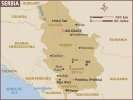
Europe farthest southeast dispersed throughout the island and the peninsula on which lies the Republic of Greece. Pindus Mountains are carved into Greece from the Albanian border in the north of the Gulf of Corinth in the south. About 70% of the country is mountainous, with steep mountain climate and poor soil Greek islands and coastal regions are characterized by a typical Mediterranean climate - winters are mild and rainy, summers dry and hot. On the northern mountains winter harsh with deep snow, and the frequent and heavy precipitation. People are mainly focused on agriculture; large conglomerates are concentrated along the east coast. Industrial life of the country rests on small plantations of tobacco, food and leather. Fishing is unavoidable activity in two thousand Greek islands. During the summer Greece is hunted by tourists because of the sun and in the winter because of its spectacular ancient ruins.
AREA: 131,940 km²
POPULATION: over 10.6 million
IMPORTANT NATURAL CHARACTERISTICS:
THE HIGHEST PEAK: Mount Olympus
THE LONGEST RIVERS: Vardar, Aliakmon
THE LARGEST CITIES: Athens, Thessaloniki, Piraeus, Patras
OFFICIAL LANGUAGE: Greek
STATE SYSTEM: multiparty republic with a unicameral parliament
THE ETHNIC COMPOSITION: Greeks (98%), others (2%)
CURRENCY: Euro = 100 cents
IMPORTANT SOURCES OF INCOME: Olive - olive oil, fruits, vegetables, tobacco, cotton, bauxite, nickel, iron ore, lead, zinc, tourism

